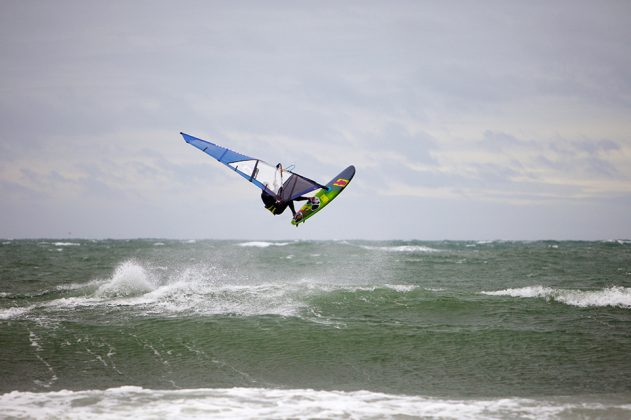CHARGE OF THE LIGHTWEIGHTS
5.0M WAVE SAIL TEST 2018
Test Editor Tris Best // Second Testers Maurin Rottenwalter,
Joe North & Dan Hallam
Photos Dan Hallam // Test location Kimmeridge, Rhosneigr,
Overcombe & Daymer Bay
As much as our test team have a real love and passion for wave sailing,
it is eminently apparent that the devotion is identical amongst the brands on review here.
This test was originally published in the November/December 2017 issue.
The reason is that there are a lot of exceptional sails in this group. Progression has been iterative and design concepts come and go, yet there is undoubtedly some correlation in the intended focus for development amongst the various sail lofts. To this end, there is not one sail here that we wouldn’t happily have in our quiver if we were to go on a tour of the various wave spots around the world. Sure, we have our own individual favourites, but such is the quality of the performances here that we wouldn’t be upset if forced to use any sail.
FINDINGS
So before we start spouting a torrent of superlatives, let’s think about what actually makes a good wave sail. The qualities are all interlinked, but what we’re all searching for is: the power when we need it, the handling to be able to use the power and the control to be able to do it over a wide wind range. And it seems the key to it all is to reduce the physical weight of the sail, without compromising structural integrity or durability. There is an extra subliminal contest between the lofts to find the best solution, be it through developing new laminates, refining panel layouts or reducing batten numbers. There are then additional techniques instilled to try and mask over the sail’s physical weight – changing batten positions, reducing the sail’s head area, or altering its geometry such as moving the centre of effort back in the draft and around the rider.
Ultimately, the big movement identified in sail design last year was this: if you can get away with using a smaller sail than you normally would in a certain wind strength, than handling will instantly be improved. For example, if you can actually be on a 5.0m sail and still have enough power to perform, when you’d have rigged a 5.3m in the past, you will instantly have a handling advantage. And this concept is still very much apparent within this 5.0m group this year. What is interesting, however, is that some very different paths of development (intended to reach the same goal) have clearly emerged. Some brands (Ezzy, North Sails and Severne) are on a mission to reduce luff curves. The benefits are instantly credible, the mast being more responsive under reduced loading, and the sail lighter and more alert as a result. Various design features are then employed to help reduce the inevitable loss in top-end stability – longer luff lengths (Severne), stretch-resistant leading-edge materials, tendons radiating from the clew, or pre-shaped panels for a locked in profile (Ezzy). There are then several other brands that have approached the size-reduction puzzle from an entirely different angle – actually increasing luff curves! In doing so, they implement a high skin tension throughout the sail and ensure stability. Their challenge is to then improve bottom end power and lightweight feel using other methods such as reducing the amount of looseness in the leech (Loftsails and Point-7). GA Sails extend upon this by offering the Manic with a convertible batten. It provides the sail with a Jekyll and Hyde persona – an extra tuning dimension to transform its character and widen its wind range. Loftsails utilise a 370cm mast instead, allowing the sail to benefit from the softer more flexible stick to breathe response into the draft. A soft mast would usually mean the sail feels too spongy in light airs, but through clever use of the right materials, panel layout and skin tension, the issue is overcome.
SUMMARY
Going through the ten sails on test, it is a job not to get too enamoured when writing their descriptions. Let’s start with the sail with the least luff curve – the Ezzy. The Elite has taken another big step forward (not only visually), providing constant power over a massive range and an improved responsive feel in the hands. The Severne Blade, North Sails SuperHero and Goya Banzai all have slightly more luff curve, yet all perform incredibly well in marginal conditions. The Blade has a fantastic natural range, its handling so balanced and neutral, making it feel so efficient. The North also has a wide wind range on just one setting, and is a bit of a speed freak off the wind, which was much appreciated in cross-off conditions. The Banzai makes use of several clever features to achieve the right balance of power and response and comfort. A hybrid luff panel of Dacron and x-ply and dual clew eyelets attached directly to the stretch tendons to name just two. The RRD Vogue also uses the hybrid luff panel concept, albeit in a subtler manner and surprised us with its get-up-and-go in light airs. The Loftsails surprised us further still with its bottom end power, given that it is recommended on a 370cm mast, whilst the Simmer resulted in the least eyebrow raising, and reminded us that the stability of five battens is still a major consideration if your local sport dictates that you sail powered or overpowered most of the time. The Point-7’s large Dacron luff panel provides the softness to temper its high skin tension and rearward centre of effort, whilst the GA Manic can be tuned and tuned again to rider preference. That leaves the Neil Pryde Combat – a self proclaimed sail for the “aggressive”. It is a yardstick for the maturity of the industry that this high-end sail, used (as all the others tested here are too) by the pros to push the ceiling of the sport as we know it, is still well within reach for even the progressing intermediate sailor. Read the individual reports for the sails, and if possible get on one yourself. You’ll be amazed at just how much these sails improve year upon year.
THE LINE UP


